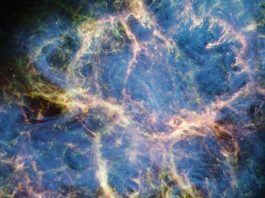Astronomers are witnessing changes never seen before in a galaxy — likely the result of the sudden awakening of a massive black hole at its core.
In late 2019, the previously unremarkable galaxy SDSS1335+0728 started shining brighter, which was believed to be caused by a massive black hole.
To understand why, astronomers have used data from several space and ground-based observatories, including the European Southern Observatory’s Very Large Telescope, to track how the galaxy’s brightness has varied.
“Imagine you’ve been observing a distant galaxy for years, and it always seemed calm and inactive,” said Paula Sánchez Sáez, an astronomer at ESO.
“Suddenly, its core starts showing dramatic changes in brightness, unlike any typical events we’ve seen before.”
The brightness is unlike anything we’ve witnessed before
SDSS1335+0728 is now classified as having an ‘active galactic nucleus’ (AGN) – a bright, compact region powered by a massive black hole – after it brightened dramatically.
Some phenomena, like supernova explosions or tidal disruption events – when a star gets too close to a black hole and is torn apart – can suddenly light up galaxies.
But these brightness variations typically last only a few dozen or, at most, a few hundred days. SDSS1335+0728 is still growing brighter today, more than four years after it was first seen to ‘switch on’.
Moreover, the variations detected in the galaxy, which is located 300 million light-years away in the constellation Virgo, are unlike any seen before, pointing astronomers towards a different explanation.
How massive black holes grow and evolve
The team tried to understand these brightness variations using a combination of archival data and new observations from several facilities, including the X-shooter instrument on ESO’s VLT in Chile’s Atacama Desert.
Comparing the data taken before and after December 2019, they found that SDSS1335+0728 is now radiating much more light at ultraviolet, optical, and infrared wavelengths.
Lorena Hernández García, co-author of the study, explained: “The most tangible option to explain this phenomenon is that we are seeing how the core of the galaxy is beginning to show activity.
“If so, this would be the first time that we see the activation of a massive black hole in real-time.”
Previous studies reported inactive galaxies becoming active after several years, but this is the first time the awakening of the black hole has been observed in real-time.
Claudio Ricci, another co-author of the study, commented: “In the case of SDSS1335+0728, we were able to observe the awakening of the massive black hole, which suddenly started to feast on gas available in its surroundings, becoming very bright.”
This is a process that has never been observed before.









